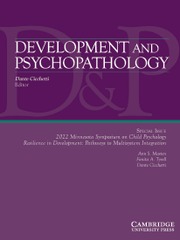No CrossRef data available.
Article contents
Neighborhood resources, parental attachment, and parenting behaviors in early childhood among parents with child protective services involvement
Published online by Cambridge University Press: 15 August 2025
Abstract
Parents involved with child protective services (CPS) often face stressors that compromise their parenting; thus, it is critical to identify sources of resilience at multiple ecological levels. This study leveraged cross-sectional data from a study of CPS-involved parent-child dyads (N = 129). Most parents identified as having a minoritized racial/ethnic identity and as having low income. Parent responsive involvement, constructive discipline, and problematic discipline were coded from observations of parent-child interactions when children were approximately 4 years old (M = 4.19 years, SD = .34; 45.7% female). Neighborhood resource availability was assessed using the Childhood Opportunity Index, a publicly available measure of resources in a given census tract. Parental attachment was coded from the Adult Attachment Interview. Greater neighborhood resource availability and secure-autonomous parental attachment were associated with reduced problematic discipline. Additionally, parental attachment moderated the link between neighborhood resource availability and responsive involvement, such that autonomous parents in more resourced neighborhoods demonstrated strengths in positive, warm parenting. These findings highlight the potential of neighborhood resources and secure attachment to strengthen parenting, even in the face of adversity, supporting the resilience of families in marginalized communities.
Information
- Type
- Regular Article
- Information
- Copyright
- © The Author(s), 2025. Published by Cambridge University Press


